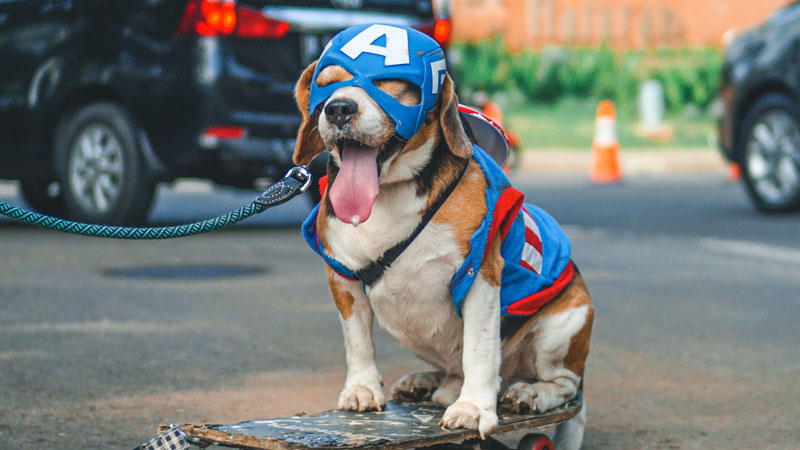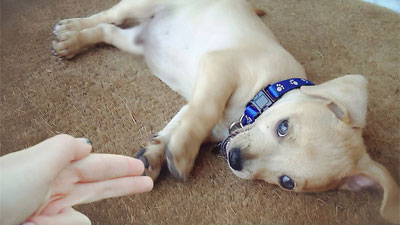- Size
- Smallest
- Small
- Small to Medium
- Medium
- Large
- Giant
- Characteristics
- Smartest
- Hypoallergenic
- Fluffy
- Best Guard
- Best Family
- Best for Kids
- Low Shedding
- Healthiest
- Police Dogs
- Most Calm
- Quietest
- Color
- White
- Black
- Grey
- Brown
- Blue
- Red
- Coat
- Hairless
- Short
- Long
- Origin
- Japan
- China
- Australia
- Germany
- Italy
- United States
- France
- Group
- Hound
- Terrier
- Herding
- Toy
- Working
- Sporting
What Is The Hardest Dog Trick?

Photo by Gema Saputera on Unsplash
Dogs, often referred to as man's best friend, are not only cherished for their loyalty and companionship but also admired for their remarkable intelligence and ability to learn various tricks. From basic commands like sit and stay to more complex maneuvers, dogs are capable of showcasing a wide range of skills. In the world of dog training, the question often arises: what is the hardest dog trick to teach and perform?
In this article, we will delve into the intricacies of dog intelligence and training to unravel some of the most challenging dog tricks, exploring the factors that make them a true test of canine capability.
Understanding Canine Intelligence
Before delving into the discussion of the hardest dog tricks, it's essential to understand the concept of canine intelligence. Dogs vary in their cognitive abilities, problem-solving skills, and learning aptitude. Stanley Coren, a renowned psychologist and dog intelligence expert, categorizes canine intelligence into three main types:
Instinctive Intelligence: This type of intelligence refers to a dog's ability to perform tasks it was bred for. For example, herding breeds like Border Collies exhibit high instinctive intelligence due to their natural herding abilities. Retrievers, with their innate retrieving instincts, also fall into this category.
Adaptive Intelligence: Adaptive intelligence relates to a dog's ability to learn from its environment and adapt to new situations. This type of intelligence is crucial for problem-solving and general learning. Dogs with high adaptive intelligence can quickly grasp new commands and tricks.
Working and Obedience Intelligence: Working and obedience intelligence refers to a dog's ability to understand and follow human commands. This is often what people refer to when discussing a dog's trainability. Breeds with high working and obedience intelligence are quick learners and can master a variety of commands.
5 Of The Hardest Dog Tricks
Now, let's explore some of the hardest dog tricks, taking into consideration the cognitive demands, physical coordination, and the unique challenges each trick presents.
1. Backflip
Teaching a dog to perform a backflip is undoubtedly one of the most challenging tricks. This trick requires a combination of physical agility, balance, and precise timing. The dog must leap into the air, tuck its hind legs, and execute a backward rotation before landing on its feet. Successfully teaching a backflip demands a strong bond between the dog and its owner, as well as a deep understanding of the dog's physical capabilities.
2. Ring Stacking
Ring stacking involves training a dog to pick up and stack rings onto a pole. This trick requires not only precise mouth control but also the ability to understand the concept of stacking. Dogs must learn to differentiate between the rings, pick them up one by one, and place them onto the pole in the correct order. The complexity of this task makes it a true test of a dog's adaptive intelligence.
3. Counting
Teaching a dog to count involves more than the rote memorization of numbers. Dogs can learn to associate specific objects with numerical values and respond accordingly. For instance, a dog might be trained to bark a certain number of times in response to a verbal command. This trick showcases a dog's ability to comprehend abstract concepts and connect them with specific actions.
4. Identifying Objects by Name
Dogs have the capacity to learn the names of various objects and retrieve them on command. This trick goes beyond simple fetch commands and requires the dog to distinguish between different items based on verbal cues. The ability to recognize and retrieve specific objects by name demonstrates a high level of cognitive understanding and working intelligence.
5. Dance Routine
Choreographing a dance routine with a dog involves a combination of physical coordination, rhythm, and a deep connection between the dog and its owner. Dogs can be taught to follow specific dance moves, such as spinning, weaving between legs, or standing on hind legs. Achieving a synchronized and entertaining dance routine demands patience, consistent training, and a dog with a natural flair for movement.
Factors Influencing the Difficulty of Dog Tricks
Several factors contribute to the difficulty level of teaching and performing dog tricks. These factors include:
Breed Characteristics: Different dog breeds have varying levels of instinctive intelligence and aptitude for certain tasks. Herding breeds, such as Border Collies, may excel in tricks that involve precision and quick decision-making, while retrievers might shine in tasks requiring gentle mouth control.
Age and Health: The age and health of a dog can impact its ability to learn and perform tricks. Younger dogs are generally more energetic and may have a shorter attention span, requiring shorter and more frequent training sessions. Older dogs may face physical limitations that affect their ability to perform certain tricks.
Owner-Dog Bond: The strength of the bond between a dog and its owner plays a crucial role in the success of trick training. Dogs that trust and feel connected to their owners are more likely to engage in the training process with enthusiasm and dedication.
Training Techniques: The methods used in training greatly influence a dog's ability to learn and execute tricks. Positive reinforcement, consistency, and patience are key elements in successful dog training. Harsh or punitive methods can hinder the learning process and create anxiety in the dog.
Tips for Teaching Challenging Dog Tricks
Successfully teaching challenging dog tricks requires a combination of effective training techniques, patience, and a deep understanding of your dog's individual capabilities. Here are some tips for tackling the most challenging tricks:
Break it Down: Complex tricks can be overwhelming for a dog if presented all at once. Break the trick down into smaller, more manageable steps. Focus on teaching each component separately before combining them into the full trick.
Use Positive Reinforcement: Positive reinforcement, such as treats, praise, and play, is a powerful motivator for dogs. Reward your dog immediately when it performs the desired behavior. This creates positive associations and encourages the dog to repeat the action.
Be Patient and Consistent: Learning a challenging trick takes time. Be patient with your dog, and consistently reinforce the desired behavior. Avoid becoming frustrated, as dogs are sensitive to their owner's emotions, and negativity can hinder the learning process.
Know Your Dog's Limits: Understand your dog's physical and mental limitations. Pushing a dog too hard or expecting too much too soon can lead to frustration for both you and your furry friend. Adapt the training process to suit your dog's individual pace and capabilities.
Seek Professional Guidance: If you find yourself struggling to teach a particularly challenging trick, consider seeking guidance from a professional dog trainer. Trainers have experience working with various breeds and can provide tailored advice to address specific challenges.
Conclusion
The world of dog tricks is a testament to the incredible intelligence and adaptability of our canine companions. While some tricks may be more challenging than others, the joy of successfully teaching a dog a new skill is immensely rewarding. The key to overcoming the difficulty of dog tricks lies in patience, positive reinforcement, and a genuine connection between the dog and its owner.
As we celebrate the diversity of dog breeds and their unique abilities, it's essential to remember that every dog is an individual with its own strengths and challenges. Whether your dog excels in backflips, ring stacking, counting, or a captivating dance routine, the journey of training and bonding is an enriching experience for both you and your furry friend. So, embrace the challenge, enjoy the process, and relish the moments of triumph as your dog masters the art of the hardest tricks.
You May Also Like
 Dog Training TipsHow To Train Your Dog To Eye Contact
Dog Training TipsHow To Train Your Dog To Eye Contact Help & AdviceWhy Won't My Dog Learn To "Stand" Command?
Help & AdviceWhy Won't My Dog Learn To "Stand" Command? Dog Training TipsThe 'Stand' Command: A Crucial Yet Overlooked Training Cue
Dog Training TipsThe 'Stand' Command: A Crucial Yet Overlooked Training Cue Dog Training TipsThe Place Command: Teach Your Dog to Go to Their Place
Dog Training TipsThe Place Command: Teach Your Dog to Go to Their Place Dog Training TipsDog Tricks: Teach Your Dog to High Five
Dog Training TipsDog Tricks: Teach Your Dog to High Five Dog Training TipsTrain Your Dog to Play Dead: A Step-by-Step Guide
Dog Training TipsTrain Your Dog to Play Dead: A Step-by-Step Guide